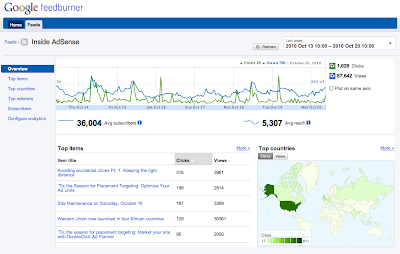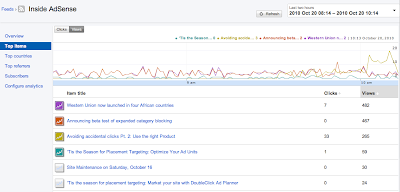Do you hate delays? Do you think being told to “Please wait…” by websites, cash machines, call centers, and the doughnut stand drive-thru guy in the year 2010 is a sure sign modern living isn’t quite meeting our collective expectations as a planet?
Good news! Today, we will be rolling out a new, experimental interface for Google FeedBurner. The real story is what’s new under the hood, however: the new interface provides real time stats for clicks, views, and podcast downloads, which means you can start seeing what content is drawing traffic from feed readers, Twitter, and other syndicated sources as it happens.
Additionally, if you use the FeedBurner Socialize service, and your platform uses PubSubHubbub or you ping us when you post, you can for the first time get stats on how much traffic your feed items are receiving from Twitter, as well as feed reading platforms like Google Reader in one place. Again, all within seconds of posting your content. Ping? Pong! Yep. That fast.
Your subscriber and reach numbers are still calculated based on a whole day's worth of requests, and are based on the traffic you received yesterday and before; but your item stats reflect the traffic you are receiving right now.
You can access the new interface by visiting http://feedburner.google.com/gfb/ or logging into feedburner.google.com and then clicking on the "Try out the NEW (beta) version!" link at the top.
The best way to see these real time features is to publish a new post and then switch to the “Last two hours” view to begin seeing updates.
To access feed management or previous analytics functionality, you can continue using the original interface at feedburner.google.com.
In the new interface, we are focusing on two things: our new real-time stats presentation and getting messages about and issues with your feed posted to the top-level dashboard, so that you can better diagnose any issues that may prevent your feed from being delivered in real time. If you have any comments or questions, look for the “Send Feedback” link at the top of the page to tell us what you think.
Posted by Dan Rodney, FeedBurner Team
Monday, October 25, 2010
Friday, April 23, 2010
Enabling social sharing with FeedFlare
Feed content is being constantly distributed via new channels and endpoints every day. More and more, these new channels involve sharing your content in social networks and applications such as Facebook, Twitter and Google Buzz.
Recently, we launched our Socialize service to help you as the publisher distribute your feed via social networks, with the first network being Twitter. If you use Blogger, you can already connect your feed to Buzz via the "connected sites" link in Buzz.
But it's equally important in the social world to make sure your subscribers can also share your feed content easily on these social networks. FeedFlare helps enable this by allowing you to configure links in your feed that promote sharing. You can do this by going to the Optimize tab FeedBurner and choosing FeedFlare, and then of course, adding some flare.
Now, we won't berate you for only doing the "bare minumum," nor do we recommend having "37 pieces of flare" in your feed - but we do think you should express yourself with at least a little flare that helps your subscribers move your content around these social networks a little easier.
To that end, just yesterday we enabled the official "Post to Google Buzz" FeedFlare in our catalog, which easily allows users to repost your content to Google Buzz, and then automatically updates the label with the number of times it was posted.
These links appear as so in your feed (though the exact presentation will vary depending on where your feed is being displayed):
Also included in our official catalog are "Share on Facebook" and others that may be relevant for your audience. If you are an old time FeedBurner user, it may be time to revisit your FeedFlare setup and add some of these new ones.
In addition, if you don't see the FeedFlare you need, you can always develop one using the FeedFlare API which is documented in our FeedFlare Developer Guide.
Posted by Steve Olechowski, FeedBurner Team
Recently, we launched our Socialize service to help you as the publisher distribute your feed via social networks, with the first network being Twitter. If you use Blogger, you can already connect your feed to Buzz via the "connected sites" link in Buzz.
But it's equally important in the social world to make sure your subscribers can also share your feed content easily on these social networks. FeedFlare helps enable this by allowing you to configure links in your feed that promote sharing. You can do this by going to the Optimize tab FeedBurner and choosing FeedFlare, and then of course, adding some flare.
Now, we won't berate you for only doing the "bare minumum," nor do we recommend having "37 pieces of flare" in your feed - but we do think you should express yourself with at least a little flare that helps your subscribers move your content around these social networks a little easier.
To that end, just yesterday we enabled the official "Post to Google Buzz" FeedFlare in our catalog, which easily allows users to repost your content to Google Buzz, and then automatically updates the label with the number of times it was posted.
These links appear as so in your feed (though the exact presentation will vary depending on where your feed is being displayed):
Also included in our official catalog are "Share on Facebook" and others that may be relevant for your audience. If you are an old time FeedBurner user, it may be time to revisit your FeedFlare setup and add some of these new ones.
In addition, if you don't see the FeedFlare you need, you can always develop one using the FeedFlare API which is documented in our FeedFlare Developer Guide.
Posted by Steve Olechowski, FeedBurner Team
Subscribe to:
Posts (Atom)



